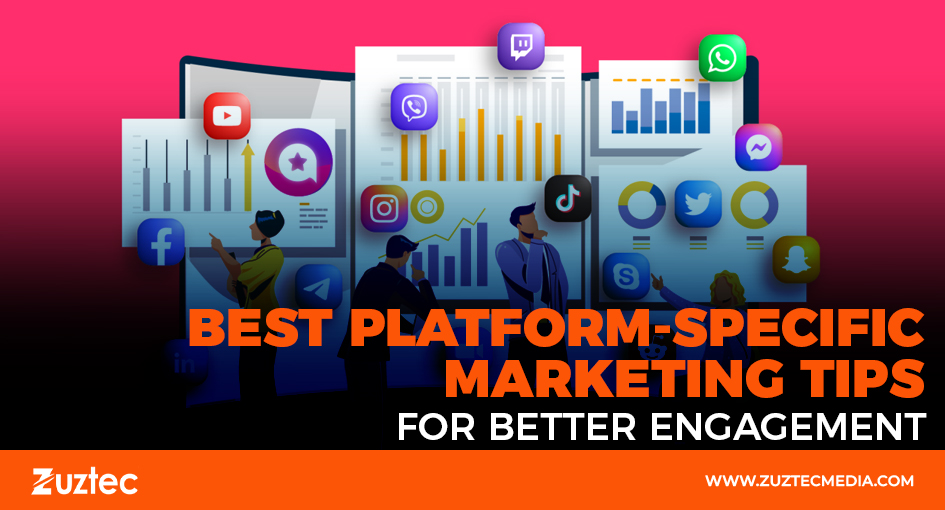
Best Platform-Specific Marketing Tips For Better Engagement
With the rapid evolution of digital platforms, marketers are realizing that a one-size-fits-all approach no longer works. Each platform has its own audience behavior, content style, and performance metrics. To maximize visibility and engagement, businesses must develop platform-specific marketing tips that align with each network’s unique features. Whether you’re promoting products, building a brand, or running ads, tailoring your approach for each platform can significantly improve your results.
For instance, Instagram is driven by visual appeal and storytelling, whereas LinkedIn is focused on professional insights and B2B communication. Twitter thrives on fast-paced updates and trending topics, while TikTok rewards short, creative, and highly engaging videos. If you post the same content across all platforms without adjusting for the audience or format, you risk getting ignored or, worse, damaging your brand’s credibility.
Understanding each platform’s algorithm is also essential. Algorithms influence what users see and interact with, so knowing how to optimize content through timing, format, and engagement tactics can greatly boost performance. Marketers who take the time to understand the specifics of each channel often see higher conversion rates and better ROI.
Incorporating platform-specific marketing into your strategy helps create more relevant content, build stronger audience connections, and drive meaningful actions. By focusing on what works best for each channel, you ensure that your brand communicates effectively, maintains consistency, and stays ahead of competitors in a crowded digital landscape.
Platform-Specific Marketing Tips For Popular Social Channels
Understanding and using platform-specific marketing is essential for any digital campaign. Not all platforms are created equal, and treating them the same leads to wasted time and poor results. To stand out, businesses need to focus on each platform’s unique strengths and user expectations.
For Facebook, long-form content, community building, and group engagement work well. Visuals should be clear, but the message is just as important. Facebook Ads allow precise targeting, so copy and images should be tailored to different segments.
Instagram, on the other hand, is all about aesthetics. High-quality visuals, behind-the-scenes stories, and interactive features like polls and questions keep users engaged. Reels are favored in the algorithm, so short-form video content should be part of the mix.
TikTok demands creativity and quick attention-grabbing hooks. Trends shift fast, so marketers must stay updated and ready to adapt.
LinkedIn is best for professional audiences. Thought leadership articles, company news, and career advice perform well. Avoid overly casual tones—content should educate, inform, or inspire a professional audience.
By customizing your approach based on these differences, your content becomes more effective and resonates more deeply with users. It’s not just about being present—it’s about being purposeful and strategic.
Creating Content That Matches Platform Behavior
Adapting your content to platform behavior is one of the most powerful platform-specific marketing. Every platform has distinct norms, formats, and preferred content types, so your strategy should reflect those expectations to drive better engagement.
For instance, Instagram’s audience engages more with visual storytelling. Your captions can be short or detailed, but the image must be compelling. Carousel posts with educational content often perform better than single images because they encourage users to swipe and spend more time on your post.
Meanwhile, YouTube focuses on long-form video content. Tutorials, product demos, and educational series work well here. You can add value by incorporating keywords in your video title and description to improve discoverability. Engagement metrics such as watch time and click-through rate are crucial for success.
Improving ROI With Smart Platform Decisions
When marketers apply platform-specific marketing tips correctly, they not only improve engagement but also drive better return on investment. Budget allocation should be influenced by platform strengths and campaign goals, ensuring that money is spent where it counts.
If you’re focused on professional services or B2B sales, LinkedIn is likely the smarter choice. Choosing where to invest based on audience behavior will naturally enhance your campaign’s success rate.
In the middle of any successful campaign, personalization is key. Retargeting ads on Facebook or using dynamic creative tools on Instagram allows brands to present tailored messages that match user behavior and interests.
Another key factor is testing and iteration. A/B testing ad formats, calls to action, or even time of posting helps identify what works best for a particular platform. Use these insights to refine your strategy and reallocate efforts where they bring the highest impact.
Ultimately, smart marketers treat each platform not as a checkbox to tick off but as a unique ecosystem requiring tailored efforts. This approach ensures higher engagement, better resource use, and a stronger overall campaign.
Conclusion: The Value Of Customizing Platform Strategy
A successful digital presence doesn’t come from spreading the same message everywhere—it comes from understanding where you’re communicating and who you’re talking to. Applying platform-specific marketing tips helps brands shape content and campaigns that speak directly to the audience on each platform.
In conclusion, brands that embrace platform-specific marketing tips not only connect more deeply with their audiences but also achieve better results from their efforts. By refining content and strategy based on where it’s being delivered, marketers ensure every post, ad, or video delivers maximum value.

